
Zerene eurydice, the California dogface butterfly, is sometimes placed in the related genus as Colias eurydice. This species is endemic to California, and is California's state insect symbol.
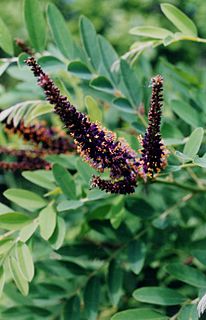
Amorpha is a genus of plants in the pea family, Fabaceae. All the species are native to North America, from southern Canada, most of the United States (US), and northern Mexico. They are commonly known as false indigo. The name Amorpha means "deformed" or "without form" in Greek and was given because flowers of this genus only have one petal, unlike the usual "pea-shaped" flowers of the Faboideae subfamily. Amorpha is missing the wing and keel petals.
The common name indigo bush can refer to plants in any of several genera in the legume family, including:

Automeris io, the Io moth, is a colorful North American moth in the family Saturniidae. The Io moth ranges from the southeast corner of Manitoba and in the southern extremes of Ontario, Quebec, and New Brunswick in Canada, and in the US it is found from Montana, North Dakota, South Dakota, Nebraska, Colorado, New Mexico, Texas, Utah, east of those states and down to the southern end of Florida. The species was first described by Johan Christian Fabricius in 1775.

Amorpha is a monotypic moth genus in the family Sphingidae erected by Jacob Hübner in 1809. Its only species, Amorpha juglandis, the walnut sphinx, was first described by James Edward Smith in 1797.

Amorpha californica is a species of flowering plant in the legume family known by the common name California false indigo.
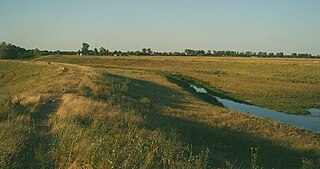
The Șurgani is a left tributary of the river Timiș in Romania. It discharges into the Timiș in Dragșina. Its length is 31 km (19 mi) and its basin size is 195 km2 (75 sq mi).

Amorpha fruticosa is a species of flowering plant in the legume family (Fabaceae) known by several common names, including desert false indigo, false indigo-bush, and bastard indigobush. It is found wild in most of the contiguous United States, southeastern Canada, and northern Mexico, but it is probably naturalized in the northeastern and northwestern portion of its current range. The species is also present as an introduced species in Europe, Asia, and other continents. It is often cultivated as an ornamental plant, and some wild populations may be descended from garden escapes.

Zerene cesonia, the southern dogface, is a North and South American butterfly in the family Pieridae, subfamily Coliadinae.

Schinia lucens, the leadplant flower moth or false indigo flower moth, is a moth of the family Noctuidae. The species was first described by Herbert Knowles Morrison in 1875. It is found in the central and western United States.
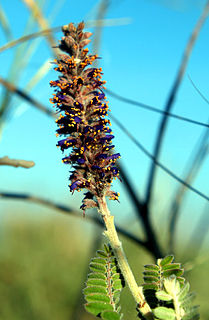
Amorpha canescens, known as leadplant, downy indigo bush, prairie shoestring, or buffalo bellows, is a small, perennial semi-shrub in the pea family (Fabaceae), native to North America. It has very small purple flowers with yellow stamens which are grouped in racemes. Depending on location, the flowers bloom from late June through mid-September. The compound leaves of this plant appear leaden due to their dense hairiness. The roots can grow up to 5 m (16 ft) deep and can spread up to 1 metre radially. This plant can be found growing in well-drained soils of prairies, bluffs, and open woodlands.

Amorpha nana is a 1–3-foot (30–91 cm) tall perennial shrub in the Pea family (Fabaceae) which is native to North America. It has vibrant green pinnate leaves and clusters of purple flowers. The fruits are small pods. Dwarf false indigo grows in dry prairies and rocky hillsides. Amorpha nana likes rocky and sandy soil.
Amorpha fruticosa 'Pendula', or Weeping Desert False Indigo, was a weeping shrub and a cultivar of Amorpha fruticosa, the Desert False Indigo. It was first described in 1868 by Élie-Abel Carrière from France. No trees are known to survive of this cultivar. Apart from the clone found in France it also seems to have been reported from the wild in Florida.

Amorpha ouachitensis is an uncommon North American species of flowering plant in the legume family known by the common names Ouachita leadplant, Ouachita Mountain leadplant, Ouachita false indigo, and Ouachita indigobush. It is native to Oklahoma and Arkansas in the United States.
Amorpha-4,11-diene 12-monooxygenase (EC 1.14.13.158, CYP71AV1) is an enzyme with systematic name amorpha-4,11-diene,NADPH:oxygen oxidoreductase (12-hydroxylating). This enzyme catalyses the following chemical reaction
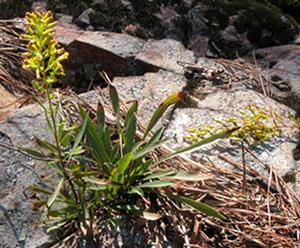
Solidago plumosa is a rare species of goldenrod known by the common names Yadkin River goldenrod, plumed goldenrod, and plumose goldenrod. It is endemic to North Carolina in the United States, where it grows only on the banks of the Yadkin River. There is only one known population. It is a candidate for federal protection.
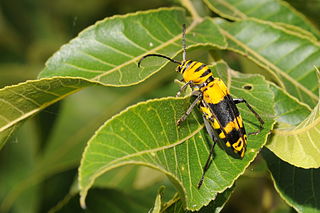
Megacyllene decora, the Amorpha borer, is a species of beetle in the family Cerambycidae occurring in the central United States. Its larvae feed only on the false indigo plant, Amorpha fruticosa, and its range largely overlaps that of the host plant. It was described by Olivier in 1795.

Katsoburi Managed Reserve is a protected area in Abasha Municipality of Samegrelo-Zemo Svaneti in the historical region of Colchis lowlands in western Georgia.
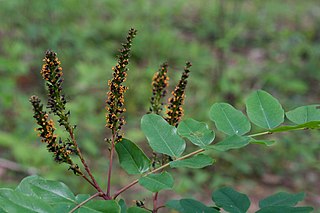
Amorpha nitens, known as shining false indigo, is a species of flowering plant in the pea family. It is native to the southern United States, in Arkansas, Tennessee, Oklahoma, Louisiana, Illinois, Alabama, Georgia, Kentucky and South Carolina.















